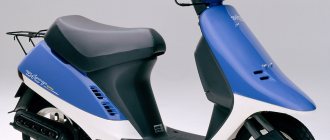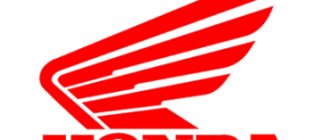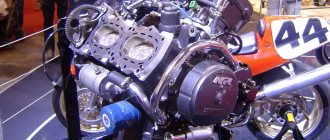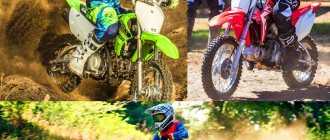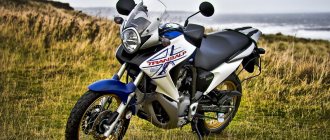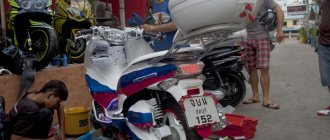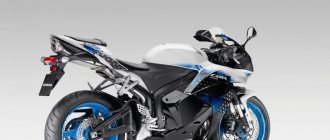honda monkey 2019
Think about it: the original Honda Monkey was designed for fun rides through the parks. Its design reflects children's ideas of what motorcycles look like. It handles like a dream. And it's named "monkey" after how it looks to an adult rider and because it's so damn fun to ride. All this, and a little more, is embodied in the new Honda Monkey
The experience of riding a modern Monkey is pure fun. This is a small motorcycle that takes us back to childhood. And while fun doesn't always require a powerful engine, if Monkey can be called a toy, it's for adults. For those adults who don't care what they look like while sitting on Monkey.
A little history
According to the Japanese version of the Honda website, the original Monkey mini-motos were created in the early 60s, when Takeo Fujisawa, a partner of Soichiro Honda, created three amusement parks in Japan so that children and adults could have fun on motorcycle rides that were exciting and fairly safe. . The Ikoma Tec and Tama Tech parks opened in April 1962, and the Suzuka Circuit park opened in January 1963.
In those days, even cars were very few in Japan, so these parks became a new thing in the entertainment industry, giving ordinary people access to motorcycles and cars. This all happened essentially in the post-war period, when austerity, low living standards and low quality products prevailed in Japan. And only years later Japan developed a production culture, developed quality standards and respect for its work.
Those parks featured Honda-made mini-motorcycles powered by 49cc Super Cub engines, giving riders an experience they couldn't get anywhere else - the thrill of motorcycle riding. Although these were rather strange rides: these mini-motos were part of one attraction, to which they were attached by rods, forming a large carousel on which all the “riders” rode along a common track. It is already difficult for us to find out the technical characteristics and safety issues of the Monkeys of that time, but they worked, the riders had fun, and the children rode them to a bright future.
A couple of years later, due to the popularity of these mopeds and their existing production capacity, Honda began mass producing the mini-moto, first releasing them as the CZ100 in the Asian and European markets, still using the 49cc powerplant. After all, in 1968 the Honda Z50A was introduced to the American market under the cheerful nickname Monkey. It had 8-inch wheels, had a folding steering wheel, and in the 1969-70 version it received a headlight and taillight, but did not yet have permission for public roads. Dual rear shocks appeared on the 1972 Monkey, significantly improving the baby's performance and transforming it from a hardcore hardtail into something that more and more fans enjoyed riding. In the first year alone, 50,000 copies were sold in the United States, which is quite impressive by today's standards.
The need for a road-going retro baby on 12-inch wheels with a more powerful engine than the 49 cc rarity was quite unexpectedly revealed after analyzing sales of the Honda Grom, which was introduced in the United States by enthusiasts in 2013. The Grom has totaled about 40,000 U.S. sales since 2013, and is arguably the current top-selling small motorcycle.
2022 Honda Monkey
The 2022 Honda Monkey shares a number of components with the Grom and is considered something of a luxury version due to its use of upscale trim parts for a retro look. Retro details include dual rear shocks, a 6-liter painted metal tank with an old-school Honda wing logo, and chromed steel fenders on the wheels. Curb weight is 105kg (ABS version 107kg), and if we compare it to the Grom (104kg), we see that they both weigh about the same and have the same power. The Monkey also uses the Grom's inverted fork and the front section of the chassis is hidden from view.
Specifications
Like the Grom, the fork angle is 25 degrees, but the trail is slightly larger at 82 mm. Considering that the Monkey's swingarm differs from the Grom's in the presence of double shock absorbers, and the wheelbase is noticeably shorter - 115 cm versus 120 cm for the Grom, the difference in the trail is quite understandable.
The Monkey is powered by the same 125cc air-cooled single overhead camshaft, dual valve engine with a four-speed transmission. It just had the caps changed to match Monkey's retro aesthetic. A catalytic converter is installed behind the engine, camouflaged by a tall exhaust pipe with a protective shield.
The saddle height is 77cm and it's not a low seat, but the narrow tank means it's more comfortable for shorter riders than many other machines of the same height.
Of course, the Monkey has many attributes of a modern motorcycle, the absence of which cannot be questioned - an electric starter, disc brakes on both wheels, fuel injection, LED lighting and an LCD instrument panel with speedometer, odometer, fuel level and two tripmeters. Tripmeters, seriously? But why not?
ABS is available as an option , and only for the front wheel, but with an inertial platform that limits the “stoppie effect” - i.e. rear wheel separation. Monkey is available in two colors: Banana Yellow and Pearl Nebula Red. There are no passenger footrests on the Monkey, so whoever needs it can buy it and install it themselves. There is also no gear indicator on the dashboard, but with four gears on such an engine it is difficult to get confused.
Generally, motorcyclists have long been biased toward larger bore engines, prompting most manufacturers to produce larger displacement models with every model update. And while we can't deny the thrill offered by liter bikes, the reality is that most small-displacement models are more than capable of handling most riding applications, from track days to touring, freeway cruising and commuting. Since these diminutive engine models are often overlooked by motorcyclists, we've dug deep into this segment to highlight the 11 best subcompact motorcycles available today in this guide.
While we tend to focus primarily on displacement when examining catalogs and specifications, there are actually several equally important factors to consider, such as engine layout, cylinder count and tuning, and engine cycle type. Below we look at our favorite models in the sub-400cc class, and also touch on some of the finer points to consider when choosing a small displacement bike.
Volume and cylinders
Why engine size matters less than you think.
Anything under half a liter is considered small displacement here and is not generally considered a high-performance model. However, over the past few years, the small-bore engine market has grown rapidly in size and popularity, with a number of motorcycle brands increasingly producing top-of-the-line 250cc motorcycles. If you give the bike a few cylinders and/or a two-stroke cycle, some of these pint-sized machines can post surprisingly fast lap times and triple-digit top speeds. As such, these bikes tend to have incredibly complex chassis designs and feature some of the best components money can buy.
Vins Motors Duecinquanta Strada
Focus on the ride
Why You Should Consider Starting Small or Downsizing
Larger motorcycles are heavier, more sensitive, less forgiving, and more difficult to ride and control. By choosing smaller bikes that will be more controllable, riders can spend more effort, energy and concentration on form and technique, body position, throttle control and other fundamental aspects of riding, rather than simply keeping the bike under control.
Besides being safer—and generally cheaper to run, whether on the street or track—smaller bikes are objectively much more conducive to skill development and growth as a rider than a regular cruiser or liter sport bike. At the end of the day, riding should be about fun, and on a price-to-fun basis, no other segment comes close to small displacement motorcycles when it comes to the fun factor.
Inspection of small motorcycles
Latest Factors to Consider When Buying Small Displacement Motorcycles
Obviously, the engine on a small displacement motorcycle is of utmost importance and should be one of, if not the first, area to consider when purchasing. After considering the powertrain layout, number of cylinders, and other major elements, the next area to consider is the chassis and components.
Honda Grom
Top speed, power and torque are also important areas to consider as these numbers give a much better idea of the actual performance of the bike than just looking at the cubic centimeters of the cylinder. Finally, some of these bikes were loaded with a variety of features that are almost exclusively reserved for expensive, high-performance motorcycles. These include traction control, launch control and various programmable fuel maps (also known as "driving modes").
Best Small Displacement Motorcycles
Now that we've made the case for why you should consider and choose a small-bore motorcycle, and shed some light on what factors and details to consider when purchasing, let's dive into our picks for the 11 best small-bore production motorcycles currently available for sale .
HUSQVARNA SVARTPILEN 125
Arguably the most stylish entry-level motorcycle on the market today, the Husqvarna Svartpilen 125 combines the Swedish marque's renowned neo-scrambler design with a small, fuel-injected, liquid-cooled engine. Despite the reduced displacement of 125cc, the moto retains the high-end WP suspension, hydroformed and robot-welded tubular steel, spoked wheels, dual-channel Bosch ABS brakes and LED lighting with its 401cc sibling. cm. As well as being great for city riding, its top speed of just over 100 km/h means the little street scrambler is good for short trips around town
Style: Neo-retro scrambler Engine: 124.7 cc cm, liquid-cooled DOHC single cylinder engine Power: 15 HP Maximum speed: 100 km per hour Weight: 145 kg Origin: Sweden
HONDA GROM
First released in 2014, the MSX125 – better known simply as “The Grom” – is a modern cult minibike that has gone on to spawn an entire sub-genre of mini nudes. And while the Grom has been in production for several years, the latest mini represents the most significant update the model has ever seen, with a new flat seat, a slightly retuned engine and a new quick-release body. The easy-to-modify Grom is ideal for customization projects with the huge range of available parts and body kits that exist for the Grom.
Style: naked minibike Engine: 124.9cc SOHC single cylinder cm air-cooled Power: 9.7 HP Maximum speed: 100 km per hour Weight: 103 kg Origin: Japan Cost : $3400
KTM DUKE 200
With its origins in the first KTM Duke in 1994, and the edgy and aggressive body design developed by KISKA, the Duke 200 offers the looks of a bigger and more menacing machine in a smaller and more affordable package. Similar to the Husky Svartpilen 125, the KTM Duke 200 is a newly launched lower-displacement version of the brand's existing barebones 390 platform. Surprisingly, the 200cc Naked's sub-$4K MSRP gets you plenty of premium components and chassis, and with a top speed of nearly 90 mph, the Austrian two-wheeler is totally city-friendly and can even offer its fair share of track-day thrills. on the track or in turns.
Style: sport naked Engine: 199.5cc DOHC single cylinder engine cm liquid-cooled Power: 25.5 HP Maximum speed: 140 km per hour Weight: 150 kg Origin: Austria Cost : $4000
HONDA REBEL 300
Although the Honda Rebel 300 is technically classified as a cruiser, its 165 kg curb weight and 149 cm wheelbase make the Japanese two-wheeler excellent for city riding. The bike features an unmistakably modern take on traditional cruiser aesthetics, with a float-style rear end, Peanuts-style tank and LED lighting front and rear. Available in two color options and sold with or without anti-lock brakes, the Rebel 300 is a much more beginner-friendly choice than larger, so-called "entry-level cruisers" like the Harley Iron 883 or Indian Scout Bobber Sixty.
Style: city cruiser Engine: single cylinder, 286 cc cm, DOHC, liquid cooled Power: 27.4 hp Maximum speed: 148 km per hour Weight: 165 kg Origin: Japan Cost : $4600
YAMAHA TW200
First released in the late 1980s and remaining virtually unchanged throughout its production, the TW200 is a versatile on- and off-road machine that is undoubtedly one of the best motorcycles in its class. Suitable for everything from commuting to off-road riding, from the street to long trips and tackling rough terrain. It has a curb weight of less than 300 pounds, a seat height of 31.1 inches, suspension travel of about 6 inches fore and aft, ground clearance of over 6 inches, and an engine with a skid plate. All this means is that the big-wheeled TW200 is more than just looks, it's actually capable of some serious off-road riding shocks.
Style: dual-sport Engine: 196cc SOHC single cylinder cm air-cooled Power: 16 hp Maximum speed: 110 km per hour Weight: 126 kg Origin: Japan Cost : $4700
HONDA CRF300L
The CRF300L is the latest generation of Honda's enduro weapon for field and forest riding, with an additional displacement of 36 cc. cm and many other mechanical tweaks compared to its predecessor 250. The moto now has 10% more power and 20% more torque. A more refined machine across the board, a lighter CRF steel frame and increased suspension travel make the bike more competent in the dirt, while new ergonomics, a slipper clutch and a revised sixth gear that now allows for higher cruising speeds mean it's capable on pavement as well. Honda also makes an ABS version of the CRF300L, as well as an HRC "Rally" version with a Dakar-style windshield with a massive engine skid plate, and a slightly higher top speed and fuel tank for just $750 over the base model.
Style: enduro Engine: 286 cc cm, liquid-cooled DOHC single cylinder engine Power: 27 HP Maximum speed: 130 km per hour Weight: 140 kg Origin: Japan Cost : $5200
SUZUKI DR-Z400SM
Around the turn of the millennium, the supermoto (or "supermotard") scene began to explode in popularity as riders equipped high-performance dirt bikes with stiffer suspension and smaller wheels wrapped in sticky street rubber. In response to this trend, a variety of manufacturers have begun offering supermoto-ready versions of their off-road motorcycles, including Suzuki with its DR-Z400SM (or "DR-Z400 Super Moto"). Not only does the 400SM's unique design make it the ultimate machine, but the 40 horsepower engine makes it a great street-riding hooligan bike. Plus, you can always swap out the supermoto wheels for knobby spoked hoops and you'll be ready to hit the dirt.
Style: supermoto Engine: 389cc single cylinder DOHC cm with liquid cooling Power: 39 hp Maximum speed: 150 km per hour Weight: 146 kg Origin: Japan Cost : $7500
DUCATI SCRAMBLER SIXTY2
Named after the year Ducati Motorcycles first launched its first Scrambler model in the 1960s, the Scrambler Ducati Sixty2 is a subcompact version of Borgo's popular Panigale line of neo-retro motorcycles that cut the standard 803cc model's engine in half. And while it shares the same aesthetic design as its larger L-Twin-engined siblings, the Sixty2 has a more budget-friendly component set and offers relatively limited performance. Still, there's something to be said for the Sixty2's aesthetic design, its build quality and the fact that it says "Ducati" on the tank, plus it's a great candidate for a custom project. Fantastic reliability and long service intervals.
Style: Neo-Retro Engine: Desmo L-Twin 399 cc air-cooled Power: 40 HP Maximum speed: 160 km per hour + Weight: 182 kg Origin: Italy Cost : $8000
KAWASAKI NINJA ZX-25R
Inspired by the high-revving multi-cylinder Japanese superbikes of the 1980s and 90s, the Kawasaki Ninja ZX-25R is an ultra-high-performance subcompact supersport powered by a quarter-liter inline-four engine that revs to 17,000 liters rpm. Not intended for novice riders, the 25R is capable of triple-digit acceleration and corners almost like it's on rails, thanks to a WSBK-derived chassis paired with a Showa Separate Function Fork Big Piston front end and monoshock. The high-revving four-cylinder engine is also controlled using the latest versions of Team Green's variable ride modes and traction control.
Style: supersport Engine: 250 cc DOHC, liquid-cooled four-cylinder engine Power: 43.5 hp Maximum speed: 188 km per hour Weight: 179 kg Origin: Japan Cost : $8500
APRILIA RS250 SP
With over 50 World Championship Grand Prix titles in the 125 and 250 classes, it's safe to say that Aprilia knows a thing or two about creating ultra-competent small-caliber firearms. And the firm's latest and greatest quarter-litre racer is the competitive RS250 SP (or "Sport Production"), a track-only race bike developed by Aprilia. Offering the performance of a true Moto3 GP racer, every element of this race bike is completely top-notch: Öhlins suspension, forged aluminum Marchesini wheels shod with Pirelli slicks, SC-Project exhaust and race-spec Brembo brakes. The RS250 SP not only allows riders to develop their riding skills, but is also incredibly easy to tune and repair.
Style: supersport Engine: 249.2cc DOHC single cylinder engine cm with liquid cooling Power: 30 hp Top speed: 220 km/h Weight: 231.5 lbs Origin: Italy Cost : $11,750
VINS DUECINQUANTA STRADA
Founded in Maranello by a pair of ex-Ferrari engineers, Vins Motors is a boutique Italian firm making wildly exotic, modern fuel-injected two-stroke supersports motorcycles. The signature Duecinquanta Strada ("250 Street" in Italian) weighs about the same as a 125 GP bike, but produces 75 hp, thanks to a two-stroke V-Twin engine with bespoke piping and servo. Controlled exhaust valves, a custom clutch, dual counter-rotating crankshafts and a six-speed removable transmission. The lightest - and also most powerful - bike in its class by a huge margin, this road-legal petrol engine is built on a carbon fiber monocoque. The frame is draped in full carbon bodywork, combined with a carbon fiber suspension with a Hossack-style front end and a cross-link monoshock.
Style: supersport Engine: 2-stroke V-twin 249.5 cc engine cm with liquid cooling Power: 75 hp Maximum speed: 209 km per hour Weight: 95 kg Origin: Italy Cost : $48,500
If you want to purchase motorcycle tires, follow the link to the euro-diski.ru store. Large selection and delivery throughout Russia.
Source: hiconsumption.com
Share with friends
Ride Monkey 2022
Riding Monkey is a breeze. Seriously, it's a simple, lightweight little bike that's a hell of a lot of fun to ride. Although, wait, there is one difficulty: the clutch is released at the very end of the handle stroke, which is why its engine has to be twisted. Was this even worth mentioning?
Although it hasn’t been compared head-to-head with the Grom, the Monkey feels a little more stable. It corners very smoothly, does not oversteer or roll over, and performs well when cornering on uneven asphalt. It's not fast, but somehow it's fun, like more serious bikes at more serious speeds.
It's amazing how clearly you realize on a simple little bike why you love motorcycles in general. And it was this simple little bike that was in the right place, at the right time, with the right design and from a good, reliable manufacturer. Let's meet in 2022 to discuss Honda Monkey sales statistics for the past 2022.
Fuel injection engine
The new 2022 Honda Monkey is fuel injected and claims a whopping fuel consumption of 1.3 liters per 100 km , which means you'll get just over 400 km on a tiny 5.6 liter tank, although anyone attempting such a miraculous feat will rather get tired of the motorcycle.
The motorcycle looks like a classic, but this is a design move; in fact, it is literally crammed with modern technologies. For example, it is equipped with a modern LCD display, full LED lighting, and ABS technology.


